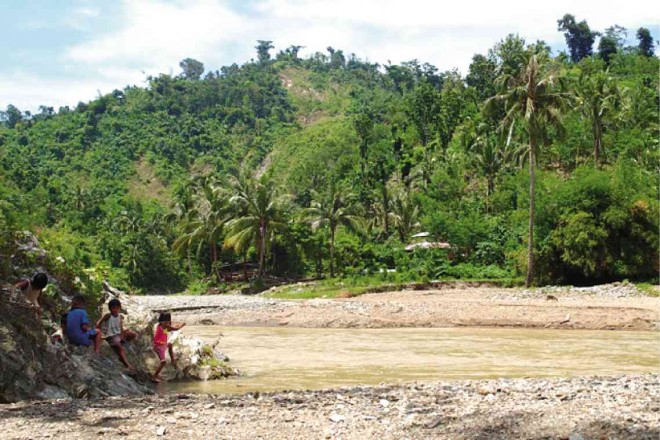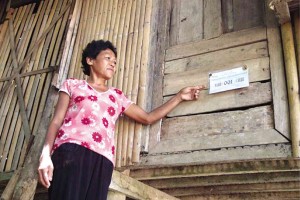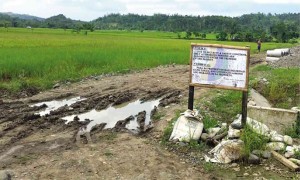Iloilo dam project divides tribal folk

FARMLANDS in Barangay Alibunan in Calinog town, Iloilo province, will be covered by the proposed P11.2-billion Jalaur River Multipurpose Project Phase II. PHOTOS BY NESTOR P. BURGOS JR.
ILOILO, Philippines – The lush green fields of palay are now littered with long strips of soil burrowed by a bulldozer in Alibunan, Badlan Grande and neighboring villages in Calinog town, Iloilo province.
Coffee and banana plantations have also been flattened for roads to be built in areas where the P11.2-billion mega dam facility called the Jalaur River Multipurpose Project Phase II (JRMP II) is expected to rise.
For government officials and other proponents of the project in Calinog, these are but signs of development—necessary sacrifices they believe will bring in a bounty of jobs and economic prosperity to the locals.
Many, however, are apprehensive that harm, not hope, will be coming to the communities.
“Our land is our only source of livelihood. I was able to send my children to school because of our farm. What will happen to us if we don’t have land anymore?” farmer Nelson Lozada, 36, asked in Hiligaynon.
Article continues after this advertisementFive hectares of Lozada’s 10-ha property in Alibunan will be caught in the frenzy of activities to construct the catch dam, a component of JRMP II. His banana and coffee crops have already been damaged.
Article continues after this advertisementNIA promises
Field personnel from the National Irrigation Administration (NIA) had promised to compensate the farmer for the losses as well as provide jobs for him and his family members.
Lozada said he was paid only P10,000, or barely enough to recover the actual cost of P30,000. “I could earn the same amount in just one harvest. But if I cannot use my land any more, that will be forever,” he said.
He said he and the other farmers had been opposing the implementation of the project but NIA personnel were persistent on their pledge of adequate compensation.
“I have not been given any job and they kept assuring us of more assistance and compensation, but nothing came. Will we continue waiting while our farms are being destroyed?” Lozada said.
Multipurpose facility
JRMP II is the second of a two-stage project aimed at tapping water for multiple uses from the Jalaur, one of the major rivers on Panay Island. It was implemented after Republic Act No. 2651 was passed in 1960 to provide the legal mandate and its governing rules of operation.
Expected to be completed in 2016, the project was bankrolled by a $203-million loan from the South Korean government through its Export-Import Bank’s Economic Development Cooperation Fund. The Philippine government provided a counterpart fund of P2.2 billion.
On Oct. 31, 2013, the Supreme Court issued a writ of kalikasan after a case was filed questioning the environmental impact of the project. It did not, however, order its suspension.
JRMP II aims to develop and enhance year-round irrigation systems for 32,000 ha of agricultural land, generate hydroelectric power and supply water to household and commercial consumers.
3 dams
The first phase was implemented from 1977 to 1983. The second involves the construction of three dams (Jalaur reservoir, afterbay and catch dams), a 6.6-megawatt hydropower plant and an 81-kilometer highline canal.
Calinog Mayor Alex Centena said the project would significantly boost the local economy, stressing that at least 17,000 jobs would be generated during the construction.
It would also attract tourists, he said.
But nine villages will bear the consequences directly and another seven indirectly. These are populated by members of the Panay-Bukidnon/Sulodnon or Tumandok, Panay’s largest indigenous group known for their rich oral literature.
Those to be directly affected are 581 families, or 2,905 persons, 1,743 ha of farmlands and 489 lots covered by a certificate of ancestral domain title (CADT), according to initial estimates of the NIA.
To be submerged due to the construction of the dam are Barangays Garangan, Masaroy, Agcalaga, Alibunan, Toyungan, Cahigon, Binolusan Pequeno, Guinbonyugan and Marandig.
According to Hermie Jun Toledo, legal officer of the regional National Commission on Indigenous Peoples, no construction activities can be done in the CADT-covered areas until the NIA secures free and prior informed consent (FPIC) from the indigenous communities.

ONE OF THE houses in Barangay Alibunan in Calinog, Iloilo, which will be relocated when the mega dam is constructed, has been marked by the National Irrigation Administration.
Getting people’s nod
The NIA secured an FCIP to conduct only a project feasibility study. The next FCIP process is expected to start within the month and will mean holding at least two assemblies in each of the 16 affected villages to get their votes.
The Iloilo-based People’s Movement for Jalaur River had questioned the construction of access roads even before the second FCIP step. But Toledo said the access roads were being prepared only in privately owned land and not in CADT areas.
Gerardo Corsiga, NIA Western Visayas manager and JRMP II manager, has denied any ongoing NIA construction work related to the project.
Divided communities
The issue has divided even the ethnic communities. Several tribal elders, especially the Caballero brothers, have voiced support for the project while others have insisted that they have not given permission for the mega dam.
Leopoldo Caballero and his brothers, Romulo and Rodolfo, are among the leaders of Panay-Bukidnon/Sulodnon who believe that the project will bring development to their communities with the creation of jobs and the building of schools, roads and other projects.
Corsiga said the residents would be paid for their crops and land, and would be resettled in areas amenable to them. Compensation will be based on the assessment of the Department of Agriculture and the Department of Environment and Natural Resources.
Still, some families do not want to leave.
“What will we do with the money? Can we get the same farmland we will be abandoning? If we can find one, is it fertile and near our house?” said Rani Chiva of Barangay Garangan.
Narciso Lorico, 65, who owns a 4-ha farm devoted to banana and coffee along the river in Garangan, the site of the high dam, said any payment would just be temporary.
“It’s not the same as having your own land. Land can be inherited by our children and grandchildren,” Lorico said.
RELATED STORIES
P500M in DAP funds went to Iloilo multi-purpose dam in Iloilo – DBM
